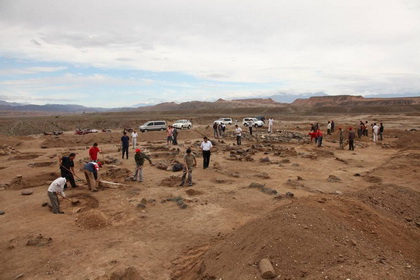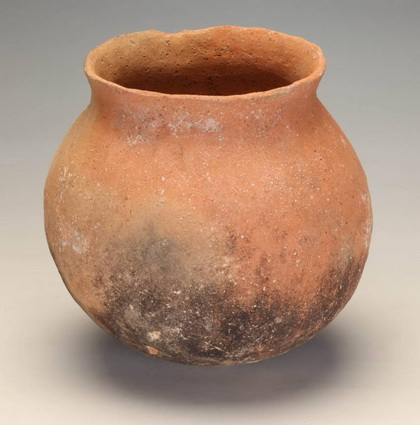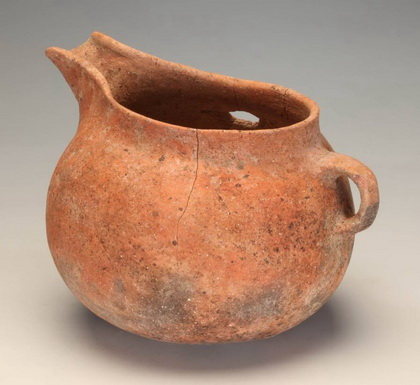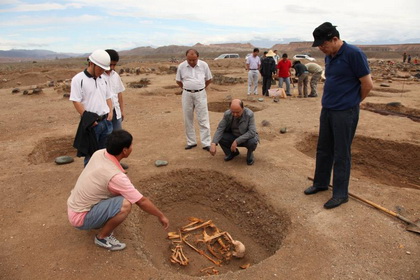New Archaeological Findings from Cemeteries II and III at Xiaoshankou, Hejing County, Xinjiang
From:Chinese Archaeology NetWriter:Date:2010-12-29

To coordinate with the secondary and tertiary hydropower station construction project at Xiaoshankou, Hejing County, Xinjiang Uighur Provincial Institute of Archaeology excavated Cemetery I in the territory of the primary station building site in 2007. From June through August, 2010, they excavated Cemeteries II and III, achieving some meaningful phasic results.
The Xiaoshankou cemeteries are located 23 kilometers southwest to Haermodun Village, Hejing County, Bayinguole Mongolian Autonomous Prefecture and 40 kilometers east to the Chawuhugou Cemeteries. During this excavation, approximately 400 tombs have been found. Specifically, 320 tombs are situated in cemetery II, the westernmost cemetery of nearly a hundred thousand square meters in size. Representing 80% of the total tombs in the cemeteries, these tombs, 120 of which were excavated, are densely yet regularly distributed. Cemetery III is roughly one hundred meters east to cemetery II.
Almost a hundred ancient tombs are located in an area extending more than 10 kilometers from east to west. They are irregularly distributed. Clusters of tombs, each of which usually consists of two or three tombs, are continuously distributed from east to west along the edge of the mesa. Fifty among them have been excavated. Most of the tombs are marked with different architectonic signs, according to which the tombs can be divided into tombs with stone fence, tombs with stone piles, and tombs with both stone fence and stone piles. Typologically, the tombs include four kinds: tombs with rectangular shaft pit, tombs with circular (oval) pit and stone chamber, tombs with rectangular pit and stone chamber, and tombs with rectangular pit and wooden coffin.

Tombs with rectangular shaft pit: Most of them are located in the west section of cemetery II and most are marked with stone fences or both stone fences and stone piles. The stone fences are usually circular in configuration. The tomb chambers are mostly east-west-oriented and rectangular with circular corners in shape. The sealing surface of the tombs are covered with wooden shed roof, on which are thatched with a layer of splendid achnatherum and stone piles. The tombs are loosely filled with yellow brownish sand grains and soil. Only a few burial objects are found inside the tombs. A layer of batten or straw mat covers the ground of some tombs. Most of the tombs are single burials. Sideways flexed second burial is the main burial form. No burial objects are found in most of the tombs. The few objects found from some tombs include pottery, bronze, wood, and gold objects. Typologically, they include pottery pots, pottery cups, bronze knives, bronze hair pins, gold earrings, and beads, among others. Most of the tombs are buried with ovine shankbones and some horse and canine bones. The tombs may be datable to about 3000 years ago.
Tombs with circular (oval) pit and stone chamber: They are located in both cemetery I and cemetery II. They usually have aboveground stone fences of stirrup or oval shape. The tomb chambers are circular or oval in configuration. Inside the tomb chambers are stone chambers built from multiple layers of pebble. In some cases, there is one wall niche at one wall of the stone chamber. Most of the tombs are joint burials with multiple tomb occupants. The main burial form is sideways flexed burial. Some tombs are onetime burials and some are second burials. The main burial objects include pottery and bronze vessels. The main pottery types include jars with a single ear and a spout, cups with a single ear and a spout, shallow dishes, and varied jars. In terms of tomb typology, burial methods, and burial objects, the cemetery and its contents show much similarity with Chawuhugou cemetery in the same area, Qunbake cemetery in Luntai County, Baileqier cemetery and Habuqihan Cemetery in Hejing County. They thus may have been constructed during the same time period.

Tombs with rectangular pit and stone chamber: They are all located in cemetery III. Most of the tombs are small with no distinct aboveground architectonic signs. They are commonly marked by rectangular or oval tumuli or stone piles with stone fences. The chambers are long and narrow. The rectangular pits are east-west-oriented with round corners. All the tombs are single burials with extended supine position burial. Majority of them are onetime burials. Some are second burials. Few burials objects are found from these tombs. Those found are mostly grey pottery jars, most of which are placed near the head of the tomb occupants. Those placed at the east end outside the stone chamber are mainly grey jars and iron knives. The tombs may be datable to the Han through the Jin dynasties.
Tombs with rectangular pit and wooden coffin:This type of tomb is mainly located in cemetery III. They are small tombs with indistinct aboveground signs such as rectangular or oval tumuli with stone fences. The rectangular tomb chambers are east-west-oriented shafts with round corners. Crate coffins are used as the main burial paraphernalia. No tenon-and-mortise works are discovered in between the planks of the coffins. The planks are simply placed on top of each other horizontally. All the tombs are single burials with extended supine position burials. Most are onetime burials and some are second burials. Few burial objects are found from these tombs. Most of the objects are placed near the head of the tomb occupants. Those placed at the east end of the stone chamber are mainly pottery jars, iron knives, iron belt hooks, iron harnesses, and bronze earrings. A few tombs are buried with such animal bones as ovine head bones. The tombs are datable to Han-Jin times.

Most of the tombs of the same kind have ovine head bones, horse head bones, and harnesses as main burial objects. Very few pottery objects are found. Most of the bronze objects are knives. Some wood vessels are also found. All these indicate that the human groups who built the tombs took nomadic economy as the chief living style.
Chawuhugou Culture is considered an important archaeological culture in Xinjiang of the Bronze Age and early Iron Age. The tombs excavated are situated within the central area of Chawuhugou Culture and chronologically earlier than that culture. They therefore are significant for future study regarding the sources of Chawuhugou Culture. (Translated by Wang Yudong)

